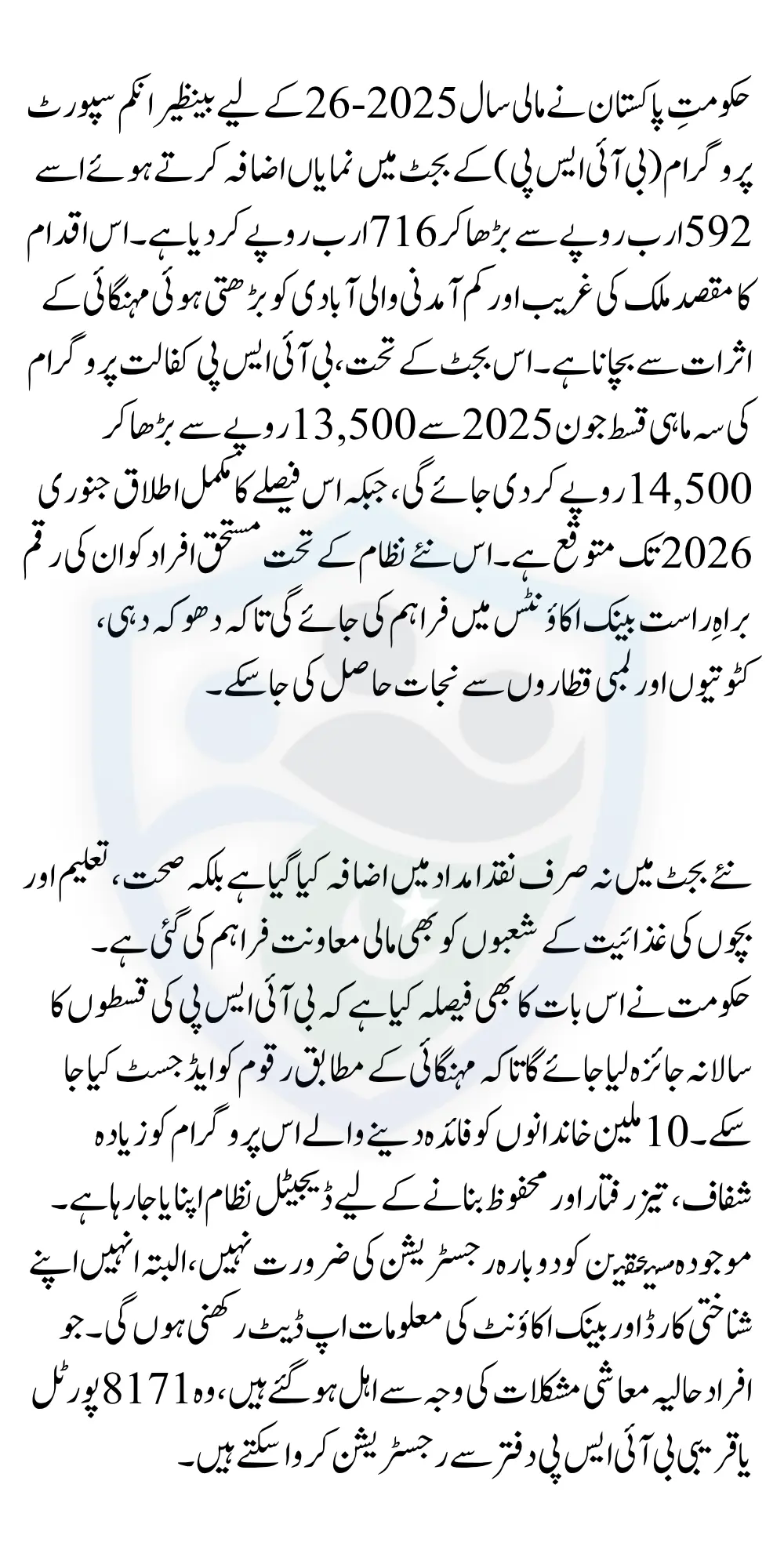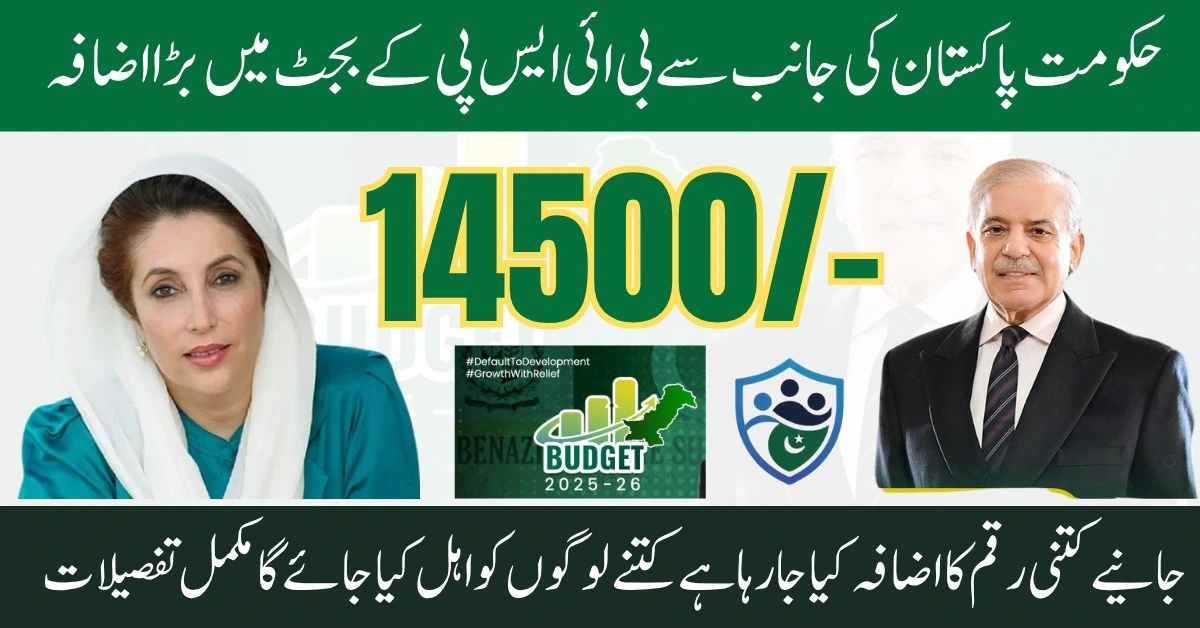BISP Kafalat Installment 14500 June 2025
BISP Kafalat Installment 14500 June 2025: In a major effort to combat poverty and support the financially vulnerable, the Government of Pakistan has taken a significant step by increasing the annual budget of the BISP For the financial year 2025–26, the allocation has been raised from Rs. 592 billion to Rs. 716 billion a more than 20% increase. This decision aims to ease the economic burden on low-income families by offering higher quarterly stipends and introducing reforms for a more efficient payment system. As part of this budgetary enhancement, the Benazir Kafalat quarterly installment will increase from 13500 to 14500, starting June 2025 with complete implementation planned for January 2026.

The increase in budget not only reflects the government’s commitment to uplift underprivileged segments of society but also introduces vital upgrades in how BISP payments will be made. With the use of digital banking channels, transparency and efficiency are expected to improve. Beneficiaries can look forward to receiving payments directly into their bank accounts, reducing dependency on agents and middlemen.
You Can Also Read: CNIC Expiry BISP Payment Issue Resolved Know Details Step By Step
BISP Kafalat Update (2025–26)
| Feature | Details |
|---|---|
| New Budget | Rs. 716 Billion |
| Quarterly Payment | Rs. 14,500 (from June 2025) |
| Beneficiaries | 10 Million Families |
| Payment Method | Direct Bank Transfer |
| Adjustment | Annually with Inflation |
| Extra Support | Health, Education, Nutrition |
Highlights of BISP Budget 2025–26
The following are the main features of the updated BISP strategy and payment system:
- New Allocation: Rs. 716 billion previously Rs. 592 billion
- New Quarterly Installment: Rs. 14,500 from June 2025 onward
- Beneficiaries Covered: 10 million families across Pakistan
- Inflation Adjustment: Payment amounts to be reviewed annually
- Disbursement Method: Direct bank transfers replacing old systems
- Supporting Sectors: Health, education, child nutrition programs
Impact of Budget Increase on BISP Beneficiaries
The increased funding will provide substantial financial relief to BISP-registered families. The raised stipend of Rs. 14,500 is intended to help beneficiaries meet their household expenses, including food, school fees, and medical bills. This decision is especially important in the context of rising inflation, which has significantly affected the purchasing power of the poor in recent years. By annually adjusting the installment based on the inflation rate, the government aims to provide sustained financial protection to low-income households.
Another major improvement is the government’s focus on eliminating delays and fraud in the disbursement system. With a plan to shift all BISP payments to verified bank accounts, the process will become more secure and transparent. Beneficiaries will no longer have to wait in long queues or pay extra charges to third-party agents. This shift not only increases convenience but also helps ensure that the full amount reaches the deserving family without any cuts or corruption.
You Can Also Read: 8171 Phase 1 June Installment has Started Know Districts List & Payment
Benefits of the New BISP Kafalat Installment
- Financial Strengthening: Increased funds will allow families to better manage essential expenses.
- Stable Support: Continuation of support to 10 million families nationwide ensures widespread social coverage.
- Annual Adjustments: The government will now assess and revise stipends annually to account for inflation.
- Digital Transformation: Moving to bank-based payments enhances transparency and removes intermediaries.
- Integrated Services: The new budget supports additional initiatives in education, healthcare, and nutrition.
How to Receive the Rs. 14,500 BISP Payment
Beneficiaries will need to ensure their CNIC is registered and verified through the BISP database. It is also essential to provide accurate banking details to receive payments directly. Those not currently enrolled in a bank account system are advised to open an account in a government-approved bank before the new installment rolls out. This step is part of the broader digital transformation that aims to make BISP more reliable, faster, and safer for all involved.
If you are an existing BISP beneficiary, you don’t need to reapply. However, make sure your contact and banking information is up to date. If your family has become eligible recently due to a drop in income or economic hardship, you can apply through the 8171 portal or visit the nearest BISP office to start your registration.
You Can Also Read: BISP Kafalat Payment Status June 2025 Check Through 8171 SMS Service
Frequently Asked Questions
What is the new BISP payment amount for 2025–26?
The new quarterly installment will be Rs. 14,500 from June 2025 onward.
Has the number of beneficiaries increased?
No, the program continues to support 10 million families.
Will the payment amount change every year?
Yes, the government will adjust the stipend annually based on inflation.
How will the new payment be delivered?
The payments will be made via bank account transfers for better security.
Is re-registration required for the new installment?
No re-registration is needed if your CNIC is already verified in the BISP database.
What else is supported under this budget?
The budget also includes support for child health, education, and nutrition programs.
Conclusion
The increase in BISP’s annual budget to Rs. 716 billion and the rise in the quarterly installment to Rs. 14,500 mark an important shift in how the government supports low-income families. This change is more than a financial update it represents a broader commitment to transparency, inclusion, and sustainable support. Through digital payment systems and inflation-indexed support, BISP aims to become a long-term safety net for Pakistan’s poorest citizens. Beneficiaries are encouraged to stay informed, confirm their eligibility, and prepare for the updated system starting mid-2025.
You Can Also Read: BISP 8171 Payment Identification Process Start For Ineligible Beneficiaries
